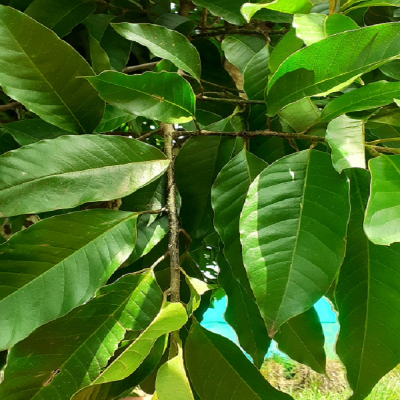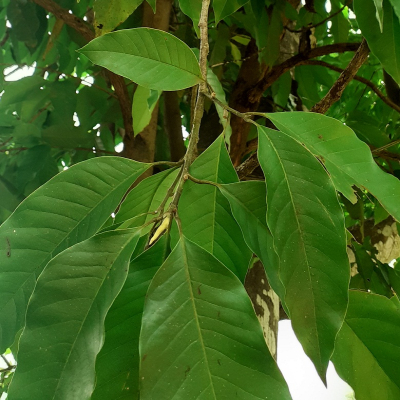Michelia champaca Linn.
Family : Magnoliaceae
Parts Used : Fruit , Flower , Oil
Vernacular Names :-
| English | : | Golden yellow champa |
| Malayalam | : | Chempakam |
| Hindi | : | Chempaka |
| Sanskrit | : | Champakh |
| Assamese | : | Sona champa, Pivala champa |
| Bengali | : | Chanpa |
| Gujarathi | : | Raichampa, Peelo champo |
| Kannada | : | Sampge |
| Tamil | : | Shampgi |
| Telungu | : | Sampangi |
Distribution and Habitat: Champak tree originated in South East Asia. By way of habitation it is found distributed in India and Nepal. It is commonly cultivated, but mainly found wild in forests. In India, it is distributed over eastern Himalayas, North East Assam, Western Ghats, Nilgiris, Tamil Nadu, Southern Orissa, West Bengal and also in Nepal.
Botany: Plant is a medium sized tree with oblong crown that grows to a height of 30 m.
- Leaves: Ovate to lanceolate, coriaceous of size 20 x 6.5 cm.
- Flowers: Yellow to orange, fragrant, solitary, axillary and bell shaped.
- Fruits: 5-10 cm long, ripe capsules ovoid or ellipsoid, valves woody.
- Seeds: 1-12, brown, angular with pink fleshy aril.
Chemical constituents: It contains important perfumery constituents such as cineole, iso‑eugenol, phenyl ethyl alcohol, benzaldehyde, methyl anthranilate, benzyl alcohol.
Properties: Champak attars are produced in India which are used in hair oils as a head coolant. Champak oil is highly esteemed in perfumery and traded in international market. Flowers also yield a dye, used as a base for other colours and for dyeing silk and cotton fabrics. By virtue of refreshing appearance of its foliage, champak looks elegant even when it is out of flowers. Leaves when distilled yield scented water.
Uses: All parts of plant have medicinal properties and are useful in treatment of various ailments like inflammation, constipation, gastritis, fever, cough, bronchitis, cardiac debility, ophthalmic disorders and urinary problems. Wood takes good polish and is used for house and carriage building and for furniture.
Formulations: Eladi taila, Mahalaxminarayana taila, Ekadashatikaprasarini taila
Agro technology:
Soil and climate: Tree thrives best in damp climate and requires deep moist soil. It is a moderate light demander and is sensitive to frost. It requires a mild climate and an elevation of 100‑1000 m with partial shade for good growth. It can be grown on a wide variety of soils, however, well drained rich sandy loam soils are the best.
Propagation: Both by seeds and vegetatively by grafting. Creamy yellow variety is propagated by grafting on rootstocks of ordinary golden orange flowered variety which produces seeds in bunches and takes 7‑8 years to flower. Seedlings of 'Simhachalam' golden orange type bear flowers in about 3 years and produce taller trees than grafts which bear fruits in a short period. Though large scale commercial cultivation of champak is not common, group planting is generally undertaken, particularly in informal gardens and homesteads. Artificial reproduction is accomplished by sowing seeds in nursery and transplanting 12-15 months old seedlings. Seedlings are pretreated with Gibberillic acid for better germination and sown at 1.5 cm depth in nursery beds. Germination commences after 38 days and completes within 70 days. Care is to be taken till grafts or seedlings are initially established in field after which not much attention is needed.
Harvesting: Trees flower during April‑May and again during September‑October once they start blooming. A well grown tree yields 50‑100 flowers daily during peak season; 375 to 425 flowers weigh one kilogram.
Processing: Champak flowers are exquisitely fragrant. Owing to presence of an oxidizing agent in flowers they become brown within a few hours after picking and are subject to odour deterioration. To prevent impairment of its odour by oxidation, essential oil must be extracted soon after picking. The volatile oil is not generally extracted by steam distillation because of poor yield and odour of that oil having no resemblance to that of the flowers. Concrete yield by solvent extraction is around 0.26% which in turn is capable of yielding 26% of steam volatile oil. Enfleuraged flowers in sesame oil yield excellent attar.




